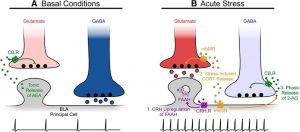In an early paper on the endocannabinoid system, published in a 1998 Trends in Neuroscience paper, Prof. Vincenzo Di Marzo and colleagues wrote about many possible actions of endocannabinoids in the nervous system. (Di Marzo V, Melck D, Bisogno T, De Petrocellis L. Endocannabinoids: Endogenous cannabinoid receptor ligands with neuromodulatory action. Trends Neurosci. 1998 Dec 21(12):521-8.) Endocannabinoids are cannabinoid-like molecules synthesized and degraded as needed in the body’s cells, and one of the three main elements of the endocannabinoid system.

Dr. Vincenzo Di Marzo
Di Marzo is research director at the Institute of Biomolecular Chemistry, National Research Council in Pozzuoli, Naples, Italy, and Canada Excellence Research Chair at University Laval, Quebec City.
Di Marzo and colleagues wrote at the time that “six years of intensive research on endocannabinoids have not yet [identified] the key physiological function of the endogenous cannabinoid system.” So they knew the endocannabinoid system was there, but they didn’t know yet what it did.
Other studies already had correlated three typical behavioral effects of cannabis smoking — appetite stimulation, anxiety relief and sedation — with the presence of cannabinoid receptors in the brain’s hypothalamus and limbic systems. And researchers in the 1998 paper had linked the same effects with possible endocannabinoid stimulation of sugar and alcohol intake, inhibition of anxiety-like responses, and decrease of arousal in rodents.
Protecting the Brain
These and other findings prompted Di Marzo and colleagues to speculate that endocannabinoids might work as stress-recovery factors by relieving typical stress-induced responses in the central and peripheral nervous systems. And they said other studies had suggested a neuroprotective (protective of the brain) role for one of the main endocannabinoids, anandamide. The other main endocannabinoid is called 2-AG.

Humain brain, vintage engraved illustration. “Manuel des hospitalière et des garde-malaldes,” edited by Librairie Poussielgue, Paris 1907. Shutterstock.
“Thus,” they wrote, “‘relax, eat, sleep, forget and protect’ might be some of the messages that are produced by the actions of endocannabinoids, alone or in combination with other mediators.”
But, they added, “several aspects of endocannabinoid biosynthesis, action and co-localization with other neurotransmitters still need to be investigated, and it will probably take many years of coordinated research among biochemists, neurophysiologists and psychiatrists to evaluate critically this or other hypotheses that relate to the physiological significance of the endogenous cannabinoid system.”
He wrote that in 1998, Di Marzo said during a 2012 interview in Tucson, Arizona, at the Patients Out of Time Seventh National Clinical Conference on Cannabis Therapeutics (Di Marzo V. CannabisPatientNet, 2012 interview).
“I was referring to the endocannabinoids [and] what their role could be, the general strategy of action. Could they be involved in stress? From what we knew about THC [the main psychoactive cannabinoid] at that time, the answer is yes,” he said, “and later this prediction was basically confirmed.”
Fighting Stress
Definitely, Di Marzo added, endogenous (made in the body) cannabinoids are produced during stressful conditions, at the isolated-cell level and at the whole-organism level, and they seem to be producing those anti-stress effects.
 “Of course, that concept was very simplistic,” Di Marzo said. “Now we know more about each of those potential functions — protection, relaxing — it accompanies the fight-or-flight system and maybe has been evolutionarily conserved to combat the consequences of stress and to [help vertebrates, which all have endocannabinoid systems] recover from stress as quickly as possible. So I would still say that concept is valid, even though it’s not so simple as it may have looked in 1998.”
“Of course, that concept was very simplistic,” Di Marzo said. “Now we know more about each of those potential functions — protection, relaxing — it accompanies the fight-or-flight system and maybe has been evolutionarily conserved to combat the consequences of stress and to [help vertebrates, which all have endocannabinoid systems] recover from stress as quickly as possible. So I would still say that concept is valid, even though it’s not so simple as it may have looked in 1998.”

Courtesy xkcd.com
Today, many years later, it’s known that the endocannabinoid system in the brain primarily influences neuronal synaptic communication and affects biological functions — including eating, anxiety, learning and memory, reproduction, metabolism, growth and development — through many actions in the nervous system (Skaper SD, Di Marzo V. Endocannabinoids in nervous system health and disease: the big picture in a nutshell. Philos Trans R Soc Lond B Biol Sci. 2012 Dec 5;367(1607):3193-200).
A Complicated System
The endocannabinoid system is very complicated, Di Marzo said during the 2012 interview. “It’s very pleiotropic [producing more than one effect at a time] and works everywhere, and it undergoes changes during nearly every physiological condition,” he said, and also during acute pathological and chronic conditions.

Cannabis plant glandular trichomes, where resin is made. Shutterstock.
“We analyze the levels of endocannabinoids and they change during the day, they have seasonal changes. Everything impacts on the endocannabinoid system both endogenously and exogenously [outside and inside the body], so it’s very complicated to work with but it’s exciting because it’s involved in everything,” Di Marzo said, adding that the work specifically on plant cannabinoids like THC and cannabidiol (CBD) and others also will be exciting.
“Because rather than designing complicated synthetic drugs,” he said, “maybe we already have the answer there and it’s just a matter of working harder and harder to understand how these compounds work and how the [endocannabinoid] system works.”


